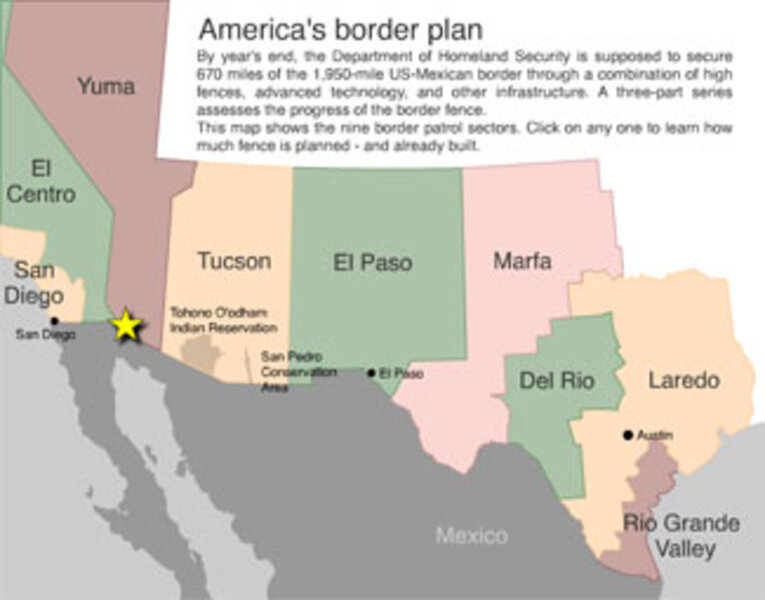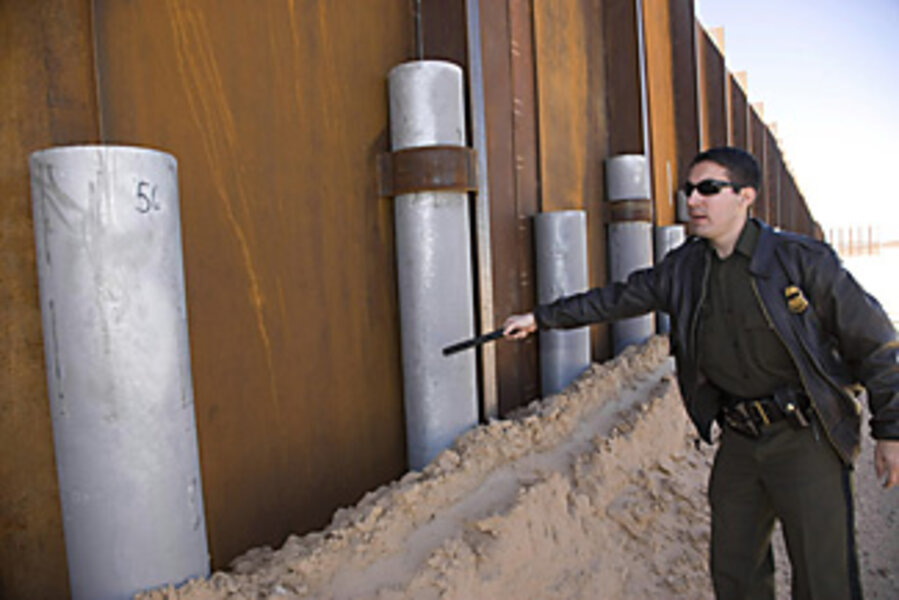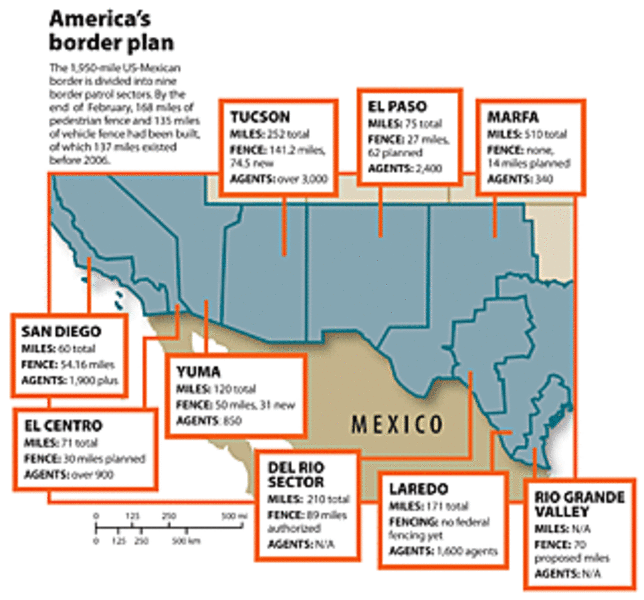Where U.S.-Mexico border fence is tall, border crossings fall
Loading...
| Yuma, Ariz.
US border patrol agent Michael Bernacke guns his SUV down the wide desert-sand road that lines the US-Mexican border through urban San Luis, Ariz.
To his right stands a steel wall, 20 feet high and reinforced by cement-filled steel piping. To his left another tall fence of steel mesh. Ten yards beyond, a shorter cyclone fence is topped with jagged concertina wire. Visible to the north, through the gauze of fencing are the homes and businesses of this growing Southwest suburbia of 22,000 people.
"This wall works," says Mr. Bernacke. "A lot of people have the misconception that it is a waste of time and money, but the numbers of apprehensions show that it works."
The triple-and double-layered fence here in Yuma is the kind of barrier that US lawmakers – and most Americans – imagined when the Secure Fence Act was enacted in 2006.
The law instructed the Department of Homeland Security (DHS) to secure about one-third of the 1,950-mile border between US and Mexico with 700 miles of double-layered fencing – and additionally through cameras, motion sensors, and other types of barriers – by the end of the year to stem illegal immigration.
Bankrolled by a separate $1.2 billion homeland security bill, the Secure Fence Act would, President Bush said in 2006, "make our borders more secure." By most recent estimates, nearly half a million unauthorized immigrants cross the border each year.
On the ground, though, things have turned out differently.
The DHS scaled back its ambitions early on, trimming its end-of-2008 target down to 300 miles of vehicle barrier and 370 miles of pedestrian barrier.
As of February, 302 miles of barrier have been constructed mostly on federal land in Arizona, New Mexico, and California, and slightly over half of this has been built under the new law.
Just $200 million will have been spent by June, according to Lloyd Easterling, the border patrol public information officer.
Only a fraction of the new barriers resemble anything like the images of formidable fencing – the Berlin Wall or the bleak monolith that divides Israel and the West Bank – envisioned by the initial proposal. Most of the new fencing is not a double wall, but a combination of regular vehicle blocks and pedestrian barriers that range from metal mesh and chain link to traditional picket fences.
And partly because of resistance from local landowners, the December deadline would be tough to meet, US government auditors have warned.
Yuma's formidable fence
In Yuma, at least, the fence seems to be preventing illegal border-crossings.
Bernacke, the patrol agent, says that since the triple fence was finished in October, there has been a 72 percent decline in illegal migrant apprehensions in the 120-mile swath of the US-Mexican border known as the Yuma sector. Eight hundred people used to be apprehended trying to cross the border here every day. Now, agents catch 50 people or fewer daily.
The 1.5-mile strip of triple fencing that cuts through suburban San Luis is the most impenetrable, says Bernacke.
That's because the three walls are separated here by a 75-yard "no man's land" – a flat, sandy corridor punctuated by pole-topped lighting, cameras, radio systems, and radar units, where unauthorized migrants can be chased down by border agents.
The triple-layer fencing begins at the San Luis port of entry, one of a handful of formal checkpoints where cars and trucks from Mexico line up, waiting for the US border patrol to inspect them for illegal contraband or migrants before they cross over. One-and-a-half miles east of San Luis, the triple fencing gives way to double fencing for about five miles, after which come another 39 miles of so-called "primary fencing" – a combination of steel mesh and steel panels fitted over bollards, or small metal and cement pillars, that stick up from the ground.
"Back in 2005 when President Bush came here, newspapers were writing that Yuma was the most dangerous place to live – and he came in and said, 'I am going to fix this' and he did," says Yuma Mayor Larry Nelson.
Conversations with residents and business owners in this town suggest the fence is not such a hot-button issue. But, violent drug smugglers aside, neither has the flow of illegal immigrants been a big issue, observers say.
That's partly because the migrants are headed through to Phoenix, Los Angeles, Las Vegas, and the Midwest.
Still, most residents support the idea of a barrier, says Terry Ross, editor of The Sun, a daily newspaper in Yuma, but also feel that "the wall is a temporary measure that won't solve the problem [of foreign workers] in the long run."
Displacing the problem
Border security has been beefed up considerably during President Bush's tenure, reflecting heightened security and immigration concerns. The budget for border security has more than doubled in this time, as has the number of border patrol agents, which is anticipated to top out at 18,000 agents by the end of this year.
But as with 1994's Operation Gatekeeper – when the Border Patrol's San Diego sector beefed up fencing, agents, and technology to keep out border-crossers from Mexico only to find they entered the country elsewhere – critics say Yuma's apparent success does not necessarily translate into a permanent solution.
Strengthening border security in Yuma may be diverting illegal immigration to rural and desert areas.
"For the Yuma sector, the numbers are telling us that the wall has had a dramatic effect," says Ken Rosevear, president of the Yuma Chamber of Commerce. "But we all know that once you shut down a pipeline in one area it merely diverts the traffic to somewhere else."
In this case, the Tohono O'odham Indian Reservation and Saguaro National Monument to the east are seeing a rise in foot traffic, he says.
Also of concern is the increase in border violence by drug and human smugglers, who seem to be more desperate now that one of their primary entry routes has been choked off. Two months ago, a border patrol agent was intentionally run over and killed in the Algadones Dunes area, in the Yuma sector, where thousands of off-road vehicles have provided cover for smugglers moving illegal migrants north in SUVs.
Assaults on agents and rock-throwing at border patrol vehicles have gone up, says senior agent Derek Hernandez, who has been patrolling the Yuma sector for the past three years.
He points to his white SUV patrol car, which has been ribbed with a kind of metal exoskeleton that folds down to protect the windshield and windows. He then reaches into the car to demonstrate what is becoming more agents' weapon of choice - an air gun that fires tear-gas-filled pellets.
Local resistance to the fence
Yuma is the US border patrol's success story of the moment. But a very small percentage of the fencing will look like Yuma's, says Mr. Easterling.
Why can't the DHS extend triple-layer fencing the entire length of the US border?
The reasons include cost and the engineering problems associated with rocky, mountainous terrain, and other natural obstructions. The urban Yuma sector is perfectly flat, able to host a wide corridor of fences.
"The terrain along the southern border of the United States with Mexico is so diverse and mountainous, that we don't need to build the same kind of fences to halt migration there," says Bernacke, who has previously served in the mountainous Wellton section of Yuma.
Such a wall is not necessary in rural areas, many claim. In border cities, illegal migrants are just a few hundred feet from transportation to take them farther north. But migrants who try to cross rural areas have miles and miles of open terrain to cross, not to mention rivers and gorges and other natural obstructions.
Farther east of Yuma and San Luis, there are other issues that some say make triple-layer walls impractical. Environmentalists say that various types of fencing affect the migratory patterns of wildlife, including important endangered species. They can block river flow and lead to fragmentation of habitat. Some environmental groups have challenged in court the border fences being built in conservation areas.
"We are concerned that fencing will isolate populations of wildlife on either side of the border – everything from common species like mule deer and coyotes to endangered species like jaguar and the cactus ferruginous pygmy owl," says Matt Clark, southwestern representative of Defenders of Wildlife.
Native american families on the Tohono O'odham Indian Reservation – which now has 75 miles of pedestrian fencing – have complained that the vehicle barrier being built on their land desecrates an ancient burial site.
And the extra patrols disrupt their daily life. "Getting back and forth to our own land on both sides of the border is now problematic," says Ophelia Rivas, a Tohono O'odham grandmother who has land on both sides of the border. "They are always hassling us for passports, which we have never had."
Some officials and local residents have expressed concern that the DHS is trampling on the rights of local citizens. A provision in the Real ID act of 2005 allows DHS Secretary Michael Chertoff to waive any and all laws "necessary to ensure expeditious construction of the barriers and roads."
He has used this power to waive endangered-species provisions, tribal protections, clean air and clean water provisions, and building/engineering standards in efforts to complete a wall near San Diego and to build a border wall in the San Pedro Riparian National Conservation Area in Arizona.
"[DHS] would get farther and do better if they would just let locals give input on many of these matters," says US Rep. Raul Grijalva (D) of Arizona. He has introduced legislation to provide more local protection from the waiver. "A little bit less arrogance by the DHS would go a long way," he says in a phone interview.
Legal challenges
Near Brownsville, Texas, many ranchers own land on both sides of the border and have refused to allow government surveyors onto their property. The Texas border is scheduled to have about 130 miles of 18-ft.-high metal pedestrian fencing, much of it near urban areas and international bridges.
On March 7, a federal judge allowed access to one ranch owner's land but ordered the government to negotiate with the owners over the price of access and potential seizure.
Even if surveyors get access, the US government still needs to be purchase or seize the land through eminent domain, then establish locations and design before building the fence.
The government also dropped lawsuits against University of Texas, Brownsville and Texas Southmost College in March, and both sides agreed instead to come up with alternatives to a fence that would have sliced through the campus.
Such local resistance and legal challenges are what partly prompted government auditors to warn of delays in building the fence on time. Richard Stana, director of Homeland Security and Justice issues with the US government General Accountability Office, told Congress March 7 that it was going to be a "challenge to get it finished by the end of the year."








